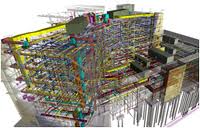

Survey data can be readily integrated into BIM models. In a recent NBS article is was noted that, “On many new build projects, clients are now insisting on the use of BIM. This is utilised through the design and construction phases, and then passed to the client at hand-over. One of the big advantages to the client is in its application to facility management and the benefits are only increased when this is multiplied across a number of sites.“
Recently, a 3D BIM competition was held in Singapore with the result of 47 teams applying and vying to be named the best project. RICS Asia also held an event in Hong Kong recently with the main aim of helping people to understand the benefits and advantages of BIM.
BIM is not without concerns. As Author Marc Goldman writes in BIMtoField, “Of course, our efforts should result in enriching (or at least not deterring any other uses) of the BIM dataset. We should still work toward creating a BIM model that is useful to the owner at project handover. But we must work towards BIM deliverables with the goal of improving our processes. Without understanding the many benefits of implementing BIM workflows (the verb), the adoption of BIM will be unnecessarily delayed and you, your team, company, project and client will fail to realize the personal and professional benefits.“
A SITECH dealership was recently established in the Philppines for the purposes of working with heavy and highway contractors. One of the goals of this group is to evolve and apply the “Trimble Connected Site solutions—site positioning systems, construction asset management services, software and powerful wireless and Internet-based site communications infrastructure.” Such integrated applications supply the framework for initiating building information systems, beginning with connecting all assets together.
In an interview with CIO-Asia, the Singapore Building and Construction Agency points to a need to build capacity for integrating BIM into the overall government services. The need to train students is highlighted as is the need to help companies wishing to explore and initiate BIM related services.
The legal implications of ownership of the BIM model for owners is investigated by Oluwole Alfred, Olatunji, School of Architecture and Built Environment, University of Newcastle, Australia. “Whilst the industry still struggles to improve on the speed of adopting and deploying these innovative technologies, the herculean task is how to create workable legal frameworks that will service the potential benefits being proposed in BIM. Some variables of contractual risks in changing technologies have been conceptualized in some recent studies; with recommendations on some useful modifications to conventional legal frameworks in e-contracting, which are not yet very definitive at present.“
Mott MacDonald, an engineering and infrastructure management company includes many ASian projects in it’s portfolio. The company has listed the Top 10 Benefits of BIM. It appears that many Asian companies, small-to-large are now embarking upon wider use of BIM and more fully integrating it into government agencies and planning frameworks.
Background info:
Solibri – World Leader in Model Checking
Tekla MIddle East
Faculty of Architecture, University of Hong Kong